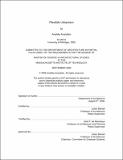Flexible urbanism
Author(s)
Anandam, Anahita
DownloadFull printable version (5.021Mb)
Other Contributors
Massachusetts Institute of Technology. Dept. of Architecture.
Advisor
Julian Beinart and John P. de Monchaux.
Terms of use
Metadata
Show full item recordAbstract
This thesis seeks to find a new approach/method towards urbanization in existing low density neighborhoods in major metropolitan cities in the United States. The near South side of the city of Chicago (a city that carries a history as the most modern city in the world in the late nineteenth and early twentieth century) will be taken as a site for development. The site of the Illinois Institute of Technology has an associated history dating back to the nineteenth century as well as an extensive housing development built as a post world war two response to a lack of housing in major metropolitan cities. Today, the area stands deserted, with a few housing tower blocks that remain occupied. The idea of flexible urbanism that would benefit the Chicago neighborhood can be traced back in history to the eighteenth century, a period during which rationality created a new type of society. Rationality is fundamental to this thesis, taken to its hilt with the idea that extreme rationality could lead to a sense of madness and diversity in options and ways of living in order to organize society today. (cont.) The idea of extreme rationality can be seen through history with the development of the prisons and asylums in the eighteenth and nineteenth century, and later in the design of the microraion, the unit of neighborhood development in the Constructivist period of the Soviet Planning process. During that period the garden city movement grew in the United Kingdom propagating the return of nature in the design of cities. A comparison to the garden city would be another new Town in England: Milton Keynes, a city where land was distinguished as separately zoned areas. These ideas of rationality and rule based zoning systems are fundamental to this thesis, and taken to its extreme to understand the city parametrically, in three dimensions. Finally, the application of this new approach towards densification shows that this strategy is one that can be used universally to revitalize, reinvigorate, and re-emphasize the use of extreme rationality in order to create vitality in cities, and diversity in use.
Description
Thesis (S.M.)--Massachusetts Institute of Technology, Dept. of Architecture, 2006. This electronic version was submitted by the student author. The certified thesis is available in the Institute Archives and Special Collections. Includes bibliographical references (leaves 95-96).
Date issued
2006Department
Massachusetts Institute of Technology. Department of ArchitecturePublisher
Massachusetts Institute of Technology
Keywords
Architecture.